What to Do When You Have Moths in the Closet

Have you ever gone to retrieve a winter coat or pull down a blanket from a high closet shelf, only to find dead moths strewn about the nooks and crannies? Or, maybe when you opened your closet door a moth fluttered past, making you question whether more of these insects may be lurking around. Worse still, perhaps you pulled out a favourite cashmere jumper, only to realise it is now riddled with moth holes.
No one ever wants to be stuck asking “How to get rid of moths in my closet?” Still, whether due to where you live, the age of your home, a lack of moth prevention knowledge, or some other stroke of bad luck, the need to eliminate these pests can arise. It’s true that moths can be nuisances, often invading closet spaces within the home. The good news is that once you know how to handle these destructive pests, you can eliminate them once and for all. You simply need to know how!
That’s why here, we are going to go over some important closet moth removal information and help you solve this frustrating issue the right way. Below, we will cover everything from how to identify closet moths (generally known as Clothes Moths or Tineola bisselliella) to how to get rid of moths in the closet without mothballs. We’ll even cover some safe and effective natural moth removal solutions so that you have plenty of options and tools in your arsenal when battling these pestilent moths and their hungry larvae.
Let’s Talk About Why Moths Invade Closets
There are many reasons that moths might make themselves at home in a closet, garage, attic, pantry, or some other storage area. Often, they find their way in through open doors, windows, or a poorly sealed crack. But don’t be too hard on yourself, moths can be very persistent when it comes to invading a home! Moreover, in many cases, moths enter a home while still in the egg stage.
Tiny moth eggs can be very hard to see, much less notice when they’re stuck to the inside of a garment or piece of furniture. Moth eggs can even be hidden in the crevices of food packaging. After a few days or weeks, the eggs hatch, and the damage begins when moth larvae start gnawing through your belongings.
The main cause of closet moths is usually the presence of natural fabrics and materials that contain keratin. Keratin is a protein found in animal based fibres such as wool, leather, and even feathers. It's the same thing that makes up your hair and fingernails, and Clothes Moth Larvae love to eat it! The adult female moths will find a spot to lay their eggs where there is a good source of protein-rich food for their larvae to eat when they hatch. These hungry larvae then consume the protein as they grow and mature into flying adults who will breed and the destructive cycle starts again.

Another cause of moths in the closet is the presence of exposed or unsealed edible dry goods. Pantry Moths (also known as Indian Meal Moths) are from the insect family Pyralidae. In the larval stage, these moths eat cereals, grains, beans, nuts, birdseed and even chocolate! They have even been known to gnaw through wicker, paper, cardboard, and hemp. So, if there are moths in your closet, they are likely to be Clothes Moths or in your kitchen and food cupboards, Pantry Moths.
Knowing Thy Enemy: How to Identify Moths in a Closet
Before you begin waging war on the moths in your home, it can be helpful to identify what type of moth you are working toward eliminating. Once you know the type of moth you are dealing with, you will be able to implement storage and moth prevention solutions to reduce the likelihood of a re-infestation taking place.
Figuring out which type of moth is causing damage is a fairly easy process. Simply look at the area they are invading and what’s stored there. Do you have food stored in your closet? Are moths infesting the food? If so, you are probably dealing with Pantry Moths.
Or, maybe you don't have any food stored in your closet, but instead, have fabric materials stored away for later. If this is the case, you are probably being targeted by Clothes Moths. Tiny holes in your clothes, dead or live larvae in your drawers, and other types of damage to items that you wouldn’t deem edible are common signs that Clothes Moths are plaguing you.
What do Clothes Moths look like?
Common Clothes Moths, also sometimes referred to as case-making or webbing moths, are weak flyers and have light brown or golden-coloured wings. The wings will usually fold flat above the body, like a paper aeroplane. They have four wings and hind wings as well, which may be tattered-looking at the edges. These moths also have a fringe of hairs, and measure between 12 and 17 mm.
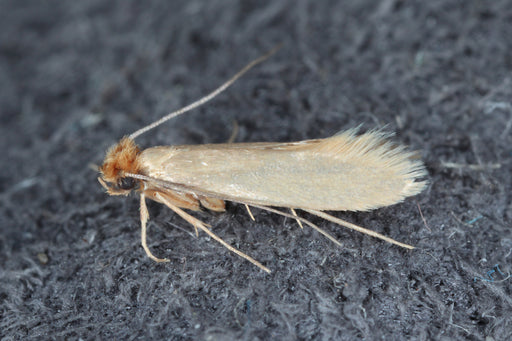
What do Pantry Moths look like?
Fully grown Pantry Moths measure about half an inch in length and have narrow, greyish, or beige wings. However, the main indicator of pantry moths is usually the presence of small, brown, or yellow larvae crawling around in food like flour or cornmeal.
What to Do to Get Rid of Moths in a Closet: 5 Steps to Solve the Problem
Now that we've covered some of the basics, let's talk about what to do when you have moths in a closet. Obviously, you want to get rid of these insects. The best thing to do is identify where an infestation is coming from, clear it out correctly, and take measures to prevent the moths from re-entering an area. Here are the steps to take to get rid of moths from your closet spaces.
Step 1: Identify the Source of the Moth Problem
First, you will want to figure out exactly where the moths are coming from. Noticing holes in your jumper or finding a dead moth in a coat pocket may indicate a Clothes Moth infestation. You will want to try to uncover where most of the larvae are congregating. This could be in your closet on an item like a wool blanket, up high on a shelf, in a drawer, etc. Since adult female moths can fly, they can lay eggs pretty much anywhere. Look high and low and leave no stone unturned.
If you do come across an item that is crawling with moth larvae, seal it up in a plastic bag immediately and set it aside. You definitely do not want an infestation spreading through your home as you clean out a closet! A heavily infested item may also indicate more eggs or larvae nearby. Err on the side of caution and assume that if you see any larvae, there are more in the vicinity.
The same goes for Pantry Moths. You should start investigating an area and identify any heavily damaged or infested food items. Watch for larvae in grain items like boxed cake mixes or flour. When you find something with live or dead larvae inside, seal it off and plan to throw it away, preferably somewhere far from your home.
Step 2: Clear Everything Out and Seal Up Damaged Items in Plastic Bags
Next, you will want to clear everything out of the closet that you believe is harbouring months. To do this, you will need some large plastic trash bags. Remove all of the items from the closet and secure them in plastic bags so that no moth larvae will escape as you work your way through a space. You can set the bags aside for now, and plan to treat any items held within them separately.
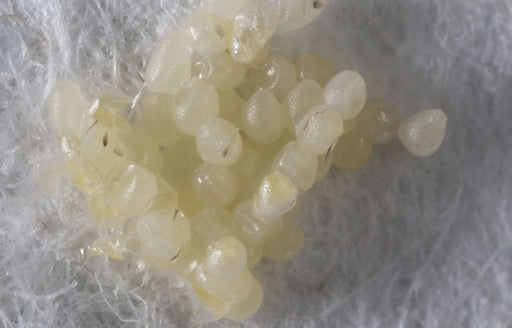
You should assume that anything that comes out of an infested closet is housing moth eggs or larvae. Just because you don't see them does not mean they are not there. Clean each item off individually, or set it aside until you can thoroughly wipe its cracks and crevices down with a cleaning solution. Remove every single item from an infested closet so that you can clean the entire area thoroughly.
Step 3: Clean and Scour the Entire Closet
Once the closet is emptied out, it’s time to roll up your sleeves and get to work cleaning. You will need to clean every nook and cranny of your closet space. This includes shelves, drawers, walls, floorboards, the undersides of furniture, and even around any light fixtures. Thoroughness is the key to eliminating the presence of moths in a space.
Get a bucket of hot soapy water and wipe down everything. From top to bottom, move your way through the closet and scrub any spots that feel sticky or grainy, as this could indicate eggs. Brush all debris toward the floor of the closet. Once you have wiped everything down, get the vacuum cleaner out and begin vacuuming up all debris. Be sure to throw away your vacuum bag far away from the house. Then, you can sweep and mop the floor and do a final wipe-down with moth-deterrent or insect-killing sprays. MothPrevention’s Clothes Moth Killer Kit contains a residual spray, Moth Traps and Fumers.
There are moth-killing solutions available that can be sprayed as you clean out your closet to kill eggs or larvae that might be crawling around. If treating a kitchen or pantry you can use a non toxic spray which is safe to use around food preparation areas.
Step 4: Treat Infested Items by Freezing, Cleaning, or Throwing Them Away

One way to treat moth-infested items from your closet is to freeze them. Pantry Moths and Clothes Moths are both intolerant to extreme temperatures. Freezing a bag full of clothes for up to 72 hours will kill any hidden adult moths, moth larvae, or eggs. If you have one of those large freezers, awesome, just seal everything off and toss it in at once in a big plastic bag! If your freezer is smaller, you can bag up items individually and freeze them one at a time. In general, 72 hours is the minimum to ensure that items will freeze all of the way through and kill hidden pests.
You can also wash clothes from the infested closet in a washing machine on the hot cycle. Or, you can have certain items dry-cleaned. Whatever route you choose to take, the goal is to remove the items from the closet and have a plan in place to treat them for moth larvae and eggs.
Remember, moth eggs can be very hard to see and may be hidden in the seams of clothing or stuck to the undersides of other items. As such, any items that you remove from an infested closet should be handled with care until they have been properly sanitised and inspected. If you come across any items that are heavily damaged, consider throwing them away. Salvage what you can and be sure not to leave potentially infested items just sitting around, as this could promote the spreading of an infestation.
Step 5: Implement Preventative Measures
Once you've dealt with a moth infestation in your closet, you should use preventative measures to keep these insects from ever returning. You will need to store any natural material clothing items, such as cashmere, wool, silk, feathers, leather, and fur, securely in airtight containers. You should also place Moth Traps in your closet. We’ll go over everything you need to know about preventing closet moths in the next section.
Preventing Moths from Coming Back and Protecting Your Closets and Home
Preventing moths from entering your closet and eating your clothes in the first place is always the best line of defence. After all, if you can deter moths and prevent them from laying eggs at all, you won't have to deal with an infestation in the first place. There are many ways to protect your things from moths and keep them out of your closets, pantries, and garages. Here are the best things to do to prevent moths from ever plaguing your home again.
Use Pheromone Moth Traps
MothPrevention Pheromone Moth Traps are fantastic little apparatuses that attract the adult male moths using powerful female pheromones on the sticky strips. By catching the adult males this helps break the breeding cycle. These traps are very affordable, safe to use around kids and pets, and ideal for small spaces like closets, attics, pantries, garages, sheds, craft rooms, and more. Remember to replace your moth traps regularly and follow all instructions on the packaging.
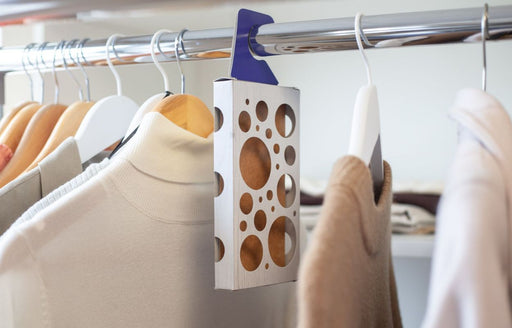
Seal Everything Off
Storing your natural material clothing items and fabrics correctly is important. You should keep these items in airtight bags or containers so that moths cannot find their way inside. Never put dirty clothes away in your closet or store linens that are soiled. It is also wise to seal off any places where moths could get inside your house. Windows, chimneys, and other areas of your home that may be exposed to the outdoors should be carefully addressed.
Inspect All Potentially Infested Items Carried Into Your Home
If you buy second-hand furniture, used rugs, or clothing items from consignment stores, always clean and inspect them before bringing them into your home and putting them away. Swap meets, consignment stores, and garage sales can be hotbeds for Clothes Moth activity. Pantry Moths often enter homes via the packaging of food items. Sometimes, these moths also infest dog food, bird seed, bulk bags of grain, flour, etc. If an item is expired, unsealed or has been sitting on a shelf for a long time, inspect it thoroughly for the presence of moth larvae.
A Note on Using Mothballs for Closet Moths
You may have noticed that mothballs are not mentioned here for moth prevention. There are a few reasons for this. For one thing, Naphthalene Moth Balls are banned in the UK and Europe due to being carcinogenic. Plus, they have a very strong, unpleasant odour. Due to their toxicity and smell, moth balls are no longer considered an ideal solution for deterring moths.
Instead, these days most people use pheromone moth traps to catch moths. Pheromone moth traps have no smell (at least none that humans can detect) are safe, and tend to be far more effective in moth prevention. These natural traps catch adult male moths and help eliminate the breeding population.
On the other hand, if you prefer using a natural moth deterrent in your clothing bins, drawers, or wardrobe, opt for cedar balls. These round spheres are made of cedar wood and not only smell great but moths don’t like them! Just make sure to use cedar ball deterrents far away from the moth traps you place. That way, these two moth preventative measures will not interfere with one another.
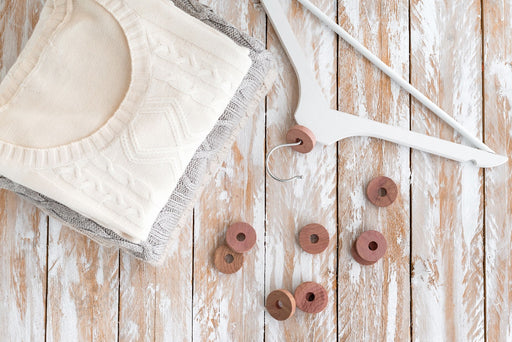
One way to do this is to place fresh cedar balls in each bin where you will be storing natural material fabrics. Then, seal the bins off. From there, you can strategically place moth traps near the entrance of your closet or bedroom. This method helps you handle the problem on all fronts.
How to get rid of moths in your closet: FAQs
Now that we've gone over how to get rid of moths in your closet and what to do if you notice the presence of moths in your home, let's go over a few frequently asked closet moth questions.
How to get rid of moths in closet naturally?
To naturally remove moths from a closet, bag up all infested items and freeze them for 72 hours. Then, thoroughly clean out the closet with a cleaning solution. Wipe all cracks and crevices and then sweep, mop, and vacuum. After you have removed all moths and moth larvae from the closet, place pheromone traps. You can also use cedar spheres to keep these moths out of bins and storage bags.
How do you get rid of moths permanently?
If you want to permanently eliminate moths from your home, be sure to clean out any infested areas and treat them thoroughly. Then, use pheromone moth traps throughout your home. Be sure to replace these traps regularly to ensure that all female moths that fly into your house will be trapped and held in place before they can lay eggs. It is also helpful to keep all stored natural fabric materials like wool, cashmere, angora, leather, etc, in airtight bins. Inspect any items that you bring home from consignment stores or garage sales for signs of moth damage, eggs, or larvae.
What can I put in my wardrobe to stop moths?
To stop moths from getting into a wardrobe, cedar spheres and sachets containing thyme, lavender, mint, and rosemary, can be very effective. Outside of your wardrobe, consider placing pheromone moth traps to ensnare female moths before they can lay eggs.
How long can moths live in a closet?
How long moths can live in a closet will depend on the extent of an infestation and how many consumable goods are available for their larvae to eat. Although Clothes Moths have a relatively short life span, they can spend their entire life in the same closet from birth to death.
Theoretically, a multi-generational infestation of moths in a closet could last for years. As long as there are plenty of natural fabric items for moth larvae to consume in the same closet, they can grow through all life stages in one place, mate, lay eggs, and repeat this process again and again.
How to get rid of moths in clothes closet?
If you have moths in your clothes closet, first, clean the entire closet out from top to bottom. Bag up and freeze all infested items for 72 hours. From there, treat the closet using moth-killing sprays. Finally, place pheromone moth traps all around your closet to prevent re-infestation from occurring.
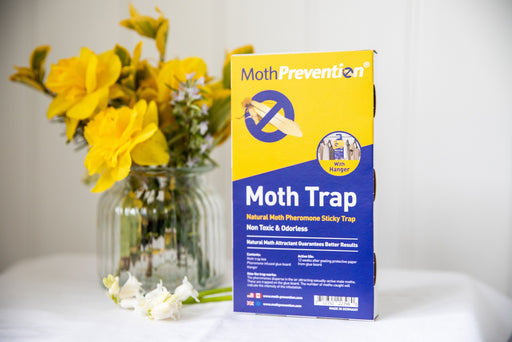
About MothPrevention
MothPrevention® speak to customers every day about their clothes moth issues - clothes moths are a species that are ever increasing and that can cause significant damage to clothes, carpets and other home textiles.
To date, we’ve helped over 150,000 customers deal with their moth problems. We have developed professional grade solutions including proprietary pheromones engineered in Germany to the highest production standards.





